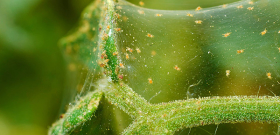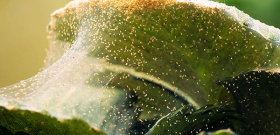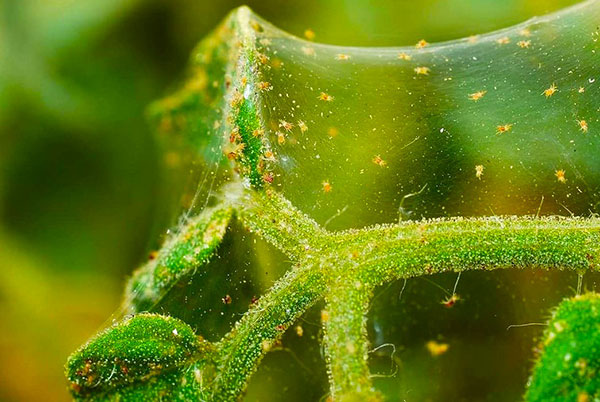
Spider mites can appear and actively multiply on almost any indoor plants. This is a very dangerous situation, because in the initial stages of infection, when it is easiest to deal with these pests, they are not visible at all, and noticeable signs of their vital activity appear when the leaves of the plant are already beginning to be damaged and there is a risk of death. At the same stage, other plants in the room are also likely to be infected, which means that it will be even more difficult to get rid of ticks: all the bushes will have to be treated with special means.
This situation is relevant for an apartment or a private house with any species set of plants. Spider mites infect almost all plants, including even succulents and palm trees resistant to many pests.
On a note
In addition to this, at home, not only true spider (or tetranych) mites can develop on plants, but also representatives of a group close to them - flat mites. They are also mistakenly called cobwebs, although they have specific features of structure, appearance and lifestyle inherent only to them. And they harm no less than tetranychids, but it is even more difficult to detect them on plants because of an important feature: they do not form cobwebs.
It is important that a heavily overgrown colony of spider mites can destroy any, even the strongest and largest bush of a plant. That is why pest control should begin as soon as they can be found.
Moreover, this fight itself is relatively simple, effective remedies for tetranychids are available and inexpensive, and the success of this event lies, first of all, in the timely detection of ticks and the speed of taking action. Let's figure out how to reliably identify spider mites on your indoor plants and what exactly you need to do first when they are detected ...
Types of spider mites that infect indoor plants
To begin with, it is useful to know what houseplant pest mites look like and by what signs they can be detected.
The most common type of tetranychid in apartments is the common spider mite. He is also the most malicious pest of garden and horticultural crops among tetranychids. It is hardly visible to the naked eye due to its small size.
For example, the photo below shows spider mites on a Mayer lemon tree:
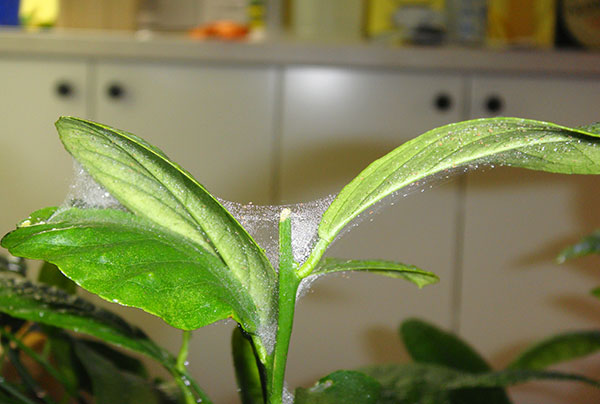
However, it is not difficult to detect these pests on a plant. To do this, pay attention to the following signs:
- Small white dots on the leaves, clearly visible when looking through the leaf into the light - they are well translucent;
- Brown spots on the leaves, small in the early stages and large in the later stages of infection. Here, the leaf tissue is already dying, there is no photosynthesis. When these spots cover more than 50% of the leaf surface, the leaf usually dies;
- White web on the surface of leaves, axils and shoots. It appears already in the later stages of infection, but it is still possible to save the plant when it is detected.Because of this web, the mites themselves are sometimes called powdery, as flower growers draw an analogy with the appearance of plants affected by powdery mildew.
If you look at the affected leaf (especially the cobweb) under a magnifying glass, you can easily see the clusters of the mites themselves. They are very small, can be pale yellow to red in color, with clearly visible dark spots along the edges of the body, and their body itself is not divided into segments by transverse constrictions.
On a note
The web of tetranych mites is very thin, and becomes noticeable only when it is massively braided with leaves. In the early stages of infection of the bush, it is easier to notice if you spray the plant with water from a spray bottle: drops of water will settle on the web and emphasize it.
The photo below shows adults of the common spider mite:

It looks like a red spider mite. Its most obvious difference from the ordinary one is the orange-red color of the integument of the body:
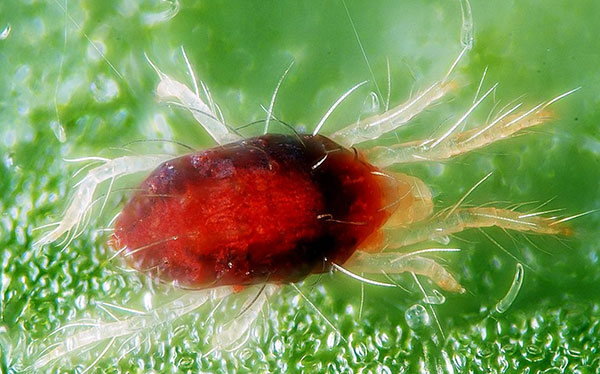
It is interesting that if the common spider mite is mainly a pest of open ground plants, and at home it appears and breeds less often than "on the street", then the red spider mite is more common in houses and apartments.
These species are often confused with flat, or false spider mites - flat beetles (the erroneous name is flat beetles). Under a microscope, they can distinguish clearly visible constrictions of the body, which tetranychids do not have:
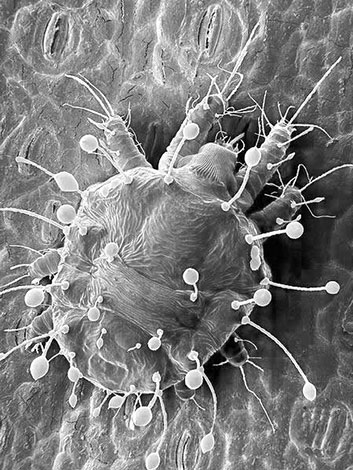
False spider mites under a microscope.
Flatworms specialize specifically in exotic plants and can infect species on which spider mites do not always settle - succulents, as well as some ferns. Of these, the most notorious pests are the following:
- Red flat mite, or citrus flatworm. Of all flat beetles, the largest number of species of domestic plants are affected;
- Greenhouse flat plant, also completely illegible in the choice of a fodder plant, but in home collections is less common than its other relatives;
- Cactus flat plant, specializing specifically in cacti, to a lesser extent in lithops, conophytums and other succulents;
- Palm flatworm, which has a huge range of food preferences and is found on most houseplants, including indoor citrus fruits, tea, orchids, violets and ferns;
- Orchid mite, most often harmful to orchids.
They can be found on plants by brown dots, in which the tissues of the leaves and stem are necrotic. Such places should be examined with a magnifying glass, since the mites are small, and the points of their injections on plants with thick fleshy leaves do not shine through. In the early stages of infestation of a bush, flat beetles are practically invisible to the naked eye, and therefore, very often, ticking is identified already with a significant reproduction of pests.
Brown mites, or bryobia, are also widely known, damaging both open ground plants and indoor flowers. The most famous in central Russia is the clover mite, which also does not produce cobwebs.
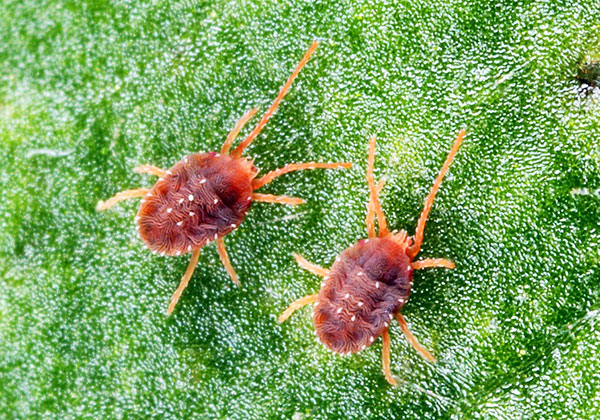
Bryobia (clover mite) does not produce cobwebs.
Other types of mites that often affect houseplants - cyclamen, Atlantic, wide - also do not belong to the spider and can be mistaken for them because of the similarity of the damage they cause.
On a note
Sometimes gamasid mites and even some other arthropods are confused with spider mites.At the same time, gamasid mites are not harmful to plants and are even beneficial, since they can eat small invertebrates - the same tetranychids, springtails, podur. Other soil mites can be both harmless to plants and very dangerous. In any case, if there are a lot of them in the ground, this is a signal that the soil is waterlogged and oversaturated with organic matter.
At home, it is almost impossible to determine a specific type of spider or flat mite on a plant. Including it will not be possible to do this by the color of the pests themselves, viewed under a microscope, or by their position on the plant. Attempts to identify the species as flower, white, earth, root or "sticky" mites are doomed to failure - in the end we have to admit that we have either a spider or a flat mite. But the main thing is that this is quite enough to take the right measures to destroy the pest.
Which plants are most harmed?
Spider mites (both real and false) affect all indoor plants, from hibiscus and violets to succulents and orchids. However, most often they are found on heavily leafy plants, the leaf plates themselves on which are simple and do not have strong pubescence.
As a rule, the most affected by ticks are:
- Hibiscus;
- Citrus fruits (lemons, tangerines, oranges). It is noteworthy that mites can also infect citrus fruits at all stages of development;
- Ficuses;
- Laurel bushes;
- Ivy;
- Euonymus;
- saxifrage;
- Dieffenbachia;
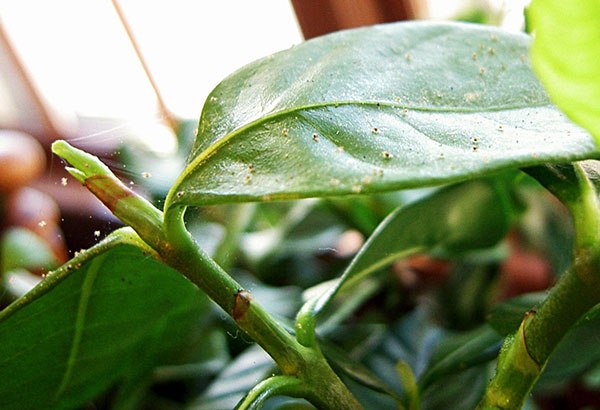
Dieffenbachia affected by spider mites.
- Hypoestes;
- Begonias.
It is very remarkable that spider mites do not affect violets and, in general, plants of the Gesneriaceae family.Reports of attacks on species of this family are a mistake that is replicated not only by numerous Internet resources, but even by books and reference books that claim to be experts. Special studies have shown that even if you keep a violet bush in close proximity and, for example, a begonia bush heavily infected with tetranychids, the violet will remain untouched.
This error is due to the fact that Gesneriaceae are often affected by flat mites, which a layman cannot always distinguish from tetranychids. Mistaking them for spider mites, a person reports a plant damage, relevant information appears on forums and other resources, and messages are sometimes taken into account when collecting statistics.
At home, there is no critical difference in whether the plant is affected by spider mites or flat mites. The harm caused by these pests is about the same, as are the measures to combat them.
Many types of mites infect cacti, agaves, aloe and kalanchoe, palm trees, ferns and orchids - plants rarely affected by other pests due to their absence in temperate climates and isolation of bushes in the home from each other. Due to this, tetranychids and flat beetles can be considered original pioneers, conquering a very specific ecological niche of indoor plants and competing in this respect with very few other arthropods.
Damage caused by tetranychids, as well as a few words about the danger to flowers
Spider and flat mites leave very characteristic lesions on plants, by which the pests themselves are quite easy to identify.The main problem is that obvious signs of damage that are conspicuous appear already during the mass reproduction of these arthropods, and in the early stages, when ticks are easiest to destroy, traces of their vital activity are hardly noticeable.
The primary damage to a plant by a tick is the death of a leaf, flower, shoot or fruit cell due to the pest sucking the juice out of it. If the sheet is thin and consists of a small number of layers of large cells, then the death of each such cell leads to the appearance of a translucent dot in its place. If such a sheet is viewed in the light, then these points are very well translucent. However, just on the bush, they are hardly noticeable, and do not pay attention to themselves.
When mites suck out the contents of a significant number of closely spaced cells, a noticeable brown spot forms in their place. Such spots are already clearly visible to the naked eye and should be a signal to start the fight against ticks. The photo clearly shows such spots on the sheet:
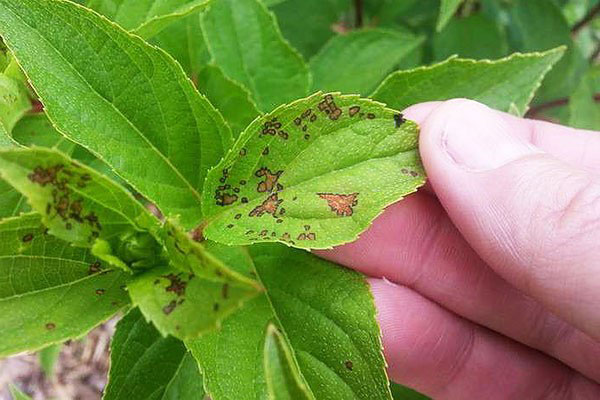
And here - on the peel of an ornamental orange:

Nearby spots gradually merge into larger ones. When such a spot covers more than half of the surface of the leaf plate, the leaf begins to die. Over time, it dries up completely.
A little later, a small web forms on the damaged leaves, at first hardly noticeable, but gradually completely covering the leaf plate. In the terminal stage of infection, thousands of ticks can be seen swarming on it, although it is difficult to see each individual pest.
Often a very dense web keeps an already dead leaf from tearing off and falling to the ground. But more often the leaf dries up even before that and falls off.
When a plant is infected with flat mites, all the same signs of damage appear, but without the formation of cobwebs on the leaves. These pests simply do not form it.
Already at the stage of the appearance of brown spots, the photosynthetic ability of the leaves of the plant decreases. This leads to inhibition of the bush, slowing down its growth, and if this happens in the flowering or fruiting phase, then to dropping flowers and fruits.
Mite infestation also exacerbates symptoms and accelerates the development of other diseases that the plant may have at this time.
As the bush loses leaves, it stops growing, and dies at a certain stage of the lesion. This outcome is possible for any plant affected by mites, but depending on the type and age of the bush, its death may occur sooner or later.
For example, succulents are generally more resistant to ticking due to the fact that the bulk of the cells in the leaves are removed from the surface and are not damaged by ticks. However, when a large number of surface cells are damaged, the plant stops photosynthesizing, cannot form new tissues and regenerate old ones, gradually fades, but its death is extended for many months.
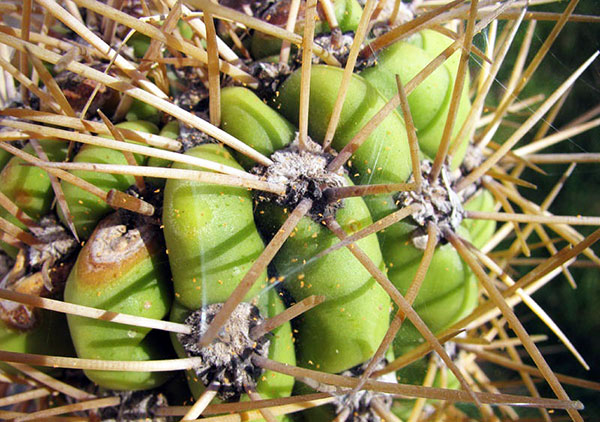
Succulents, including cacti, are rarely, but still attacked by spider mites.
Citrus fruits affected by mites are edible, although their peel may look unappetizing. However, if the plant itself is severely affected by tetranychids, the fruits on it usually do not have time to ripen and become suitable for human consumption.
The most vulnerable plants can die from ticks in 5-8 months.More resistant ones can survive with ticks for up to 2-3 years, but without measures taken to exterminate pests, they will also die sooner or later.
How to deal with spider mites at home
In almost all cases, with the right approach, mites can be removed from a plant or from all infected plants in the house. The challenge is to cure your exhibits before they die, and ideally before the mites damage most of the leaves.
The most effective, quick and reliable method of killing ticks is to treat the infected plant with acaricidal preparations. For the most part, such drugs are affordable and easy to use, while they give a quick result: ticks die within a few hours after spraying the bush. Given the characteristics of the biology of ticks, such plant treatments must be carried out several times, but these measures allow you to completely destroy the pests.
On a note
A similar, but less pronounced and usually more prolonged result can be achieved by spraying infected plants with preparations prepared according to folk recipes. The feasibility of such measures as a whole looks somewhat doubtful: the cost of highly effective insecticides is not much higher than the cost of raw materials for folk remedies, safety, subject to the instructions, is acceptable for home use, but the effectiveness of chemicals is incomparably higher. However, some people are purposefully looking for folk remedies, being convinced of their complete safety.
In industrial greenhouse farms, the method of biological control of tetranychids is widely used using their natural enemies - predatory mites - phytoseiulus, less often - neoseiulus, amblyseus, galendromus and some others. They destroy spider mites many times more effectively and safely than any drugs do. However, this method is not applicable to domestic conditions, since for the stability of the predatory mite population, there must be a lot of tetranychids - much more than they can develop even in a large collection of domestic flowers. Such biological control is relevant specifically for large greenhouses and large greenhouses.
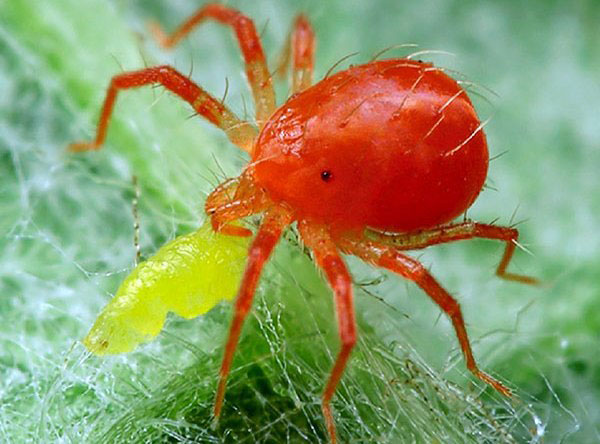
Phytoseiulus are predatory mites. These are active assistants in the fight against spider mites and other parasites on plants.
Of the ineffective methods, we can mention attempts to freeze or, conversely, the destruction of ticks by high temperatures. To do this, plants are sometimes taken out into the cold for 30-40 minutes, or placed near heaters, achieving warming up the surface of their leaves to 50-55 ° C. With such fluctuations in temperature, some of the pests die, but since it is impossible to keep the plant in the cold or under hot rays for a long time, some part of the mites and almost all of their eggs will remain viable. That is, such measures will not help to completely defeat ticks, but only temporarily reduce the degree of damage to the plant.
The most effective remedies for spider mites
All effective acaricides are divided into several groups according to the principle of action.
The first group includes nerve agents.Penetrating into the body of a tick, the active substance of any of these drugs leads to paralysis and rapid death. At the same time, the active substances of such agents may belong to different classes of chemical compounds, but the mechanism of their action is similar.
This group includes:
- Fitoverm, Aktofit, Vertimek. The active substances in them are compounds of the avermectin group, which penetrate the cells of the plant and enter the body only of feeding ticks. Therefore, eggs and non-feeding females do not die when using these drugs, and therefore, for the complete destruction of pests, the drugs must be used in a course of several treatments.;

Nerve-paralytic insecticides of the avermectin group.
- Karbofos, Actellik, Fozalon, Fufanon are preparations based on organophosphorus compounds. When using them, the action is realized, including in the fumigation phase, which increases their efficiency and allows limited destruction of eggs. However, these tools are quite toxic to humans, require strict safety measures during operation, and due to frequent use, they can misfire due to the resistance of individual populations of ticks to them. For the same reason, Dichlorvos belonging to this group is not used.
Pyrethroid-based preparations against ticks are rarely used due to frequent cases of pest resistance to them.
Today, agents based on hormonal compounds are actively used to combat spider mites:
- Flumite, Apollo are effective drugs, the active ingredients of which are hormones specific to ticks (do not act on people and pets), they lead to the sterilization of females and disruption of the development of all immature stages of ticks. As a result, adults do not reproduce, nymphs lose their ability to molt, and embryo development stops in eggs. With simultaneous treatment with them and products based on avermectins, you can get rid of pests at a time;

Preparations based on hormonal compounds, leading to infertility in females.
- Oberon, Judo, Envidor, Movento are inhibitors of lipid metabolism. They disrupt the processes of synthesis of body integuments in nymphs and the formation of eggs in females, which leads to the termination of the reproductive cycle in pests on the treated plant.
Preparations based on pyridaben (Taurus, Sunmite) and hexythiazox (Nissoran) can also be used against flatworms. They are good because today they are still not very common, and ticks resistant to them are not known.
It is impossible to choose the best of these funds. The results obtained from their use are almost the same for all drugs, and differ only in the speed of action and the number of ticks dying during each treatment. The safest among them are hormonal ones, since they do not affect humans and pets at all. The fastest acting are nerve agents.
To kill ticks, these preparations must be diluted in water at the concentrations indicated in the instructions for use, and then the plant should be treated with the resulting solution so that the agent settles on all affected surfaces, including on the underside of the leaves, in their axils and inside the flowers.The more completely all surfaces are processed, the more likely it is that there will be no live mites on the plant.
In accordance with the instructions for use, by one means or another, the plant may need to be re-treated. This is all the more relevant if we take into account the formation of stages of non-feeding wintering females, which can leave plants and hide in crevices indoors, and after a few months move back to the bushes.
Folk remedies and the effectiveness of their use
As an alternative to chemical acaricides against spider mites, it is sometimes recommended to use folk remedies. They are prepared from available raw materials in various home ways.
For example:
- A solution of alcohol in water (sometimes just diluted vodka);
- Thick soapy solution;
- Strong garlic infusion;
- Infusion or decoction of calendula flowers;

At home, an infusion or decoction of marigolds (calendula) is sometimes used as a folk remedy to combat spider mites.
- Infusion of flower stalks and dandelion leaves;
- A decoction of cyclamen tubers.
For each of these products, there are several recipes that are more or less different from each other, since each grower is actively experimenting with concentrations and quantities. However, such home remedies are significantly inferior in effectiveness to chemical preparations and very rarely completely get rid of spider mites on houseplants.
Help the plant after the destruction of mites
Often, after removing ticks, the plant needs serious rehabilitation, without which the bush may die even in the absence of pests.Even if the bush did not suffer very much, it is recommended to treat it for the speedy restoration of the vegetative part and the resumption of growth.
As a minimum, leaves that have brown spots covering more than 60% of the surface should be removed from the damaged plant. However, if there is reason to believe that a particular sheet can survive and not dry out, it can be left.
If spots and cobwebs are found on all leaves of a plant, all buds, flowers, ovaries and fruits must be removed from it so that the resources of the bush are not spent on them and it can recover.
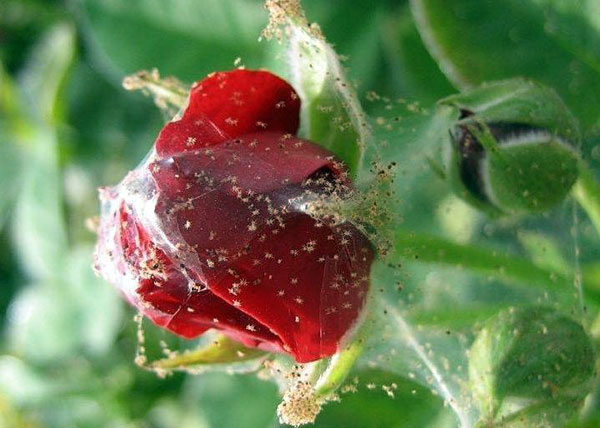
When trying to save the plant, you will have to remove all the ovaries.
If possible, the affected bushes should be fed with organic nitrogenous fertilizers that stimulate the restoration of the vegetative part of the bush. At the same time, the bushes need to be actively watered, while avoiding waterlogging of the soil. Hydrophilic plants after the destruction of mites, it is useful to spray frequently with water.
Protecting plants from spider mites
Both after successful removal of mites, and before meeting with them, all houseplants should be actively protected from ticks. To carry out such prevention is actually not as difficult as it seems - it only requires observance of obvious and relatively simple measures.
The infection of the plant itself occurs by the active stages of ticks (more often by adult females, less often by nymphs), spreading from other plants. Therefore, almost always the reasons for the appearance of these pests on the bushes are their transfer from new plants brought into housing. Moreover, these may not necessarily be indoor bushes - ticks can be brought, for example, with greens, vegetables and fruits from the market, with flowers in a bouquet, with willow branches brought for the holiday.
It happens that one tick literally flies into an apartment through a window on poplar fluff or a piece of a leaf from a tree, and successfully falls into a pot with a potted flower - this is enough to start a new colony, although the landlord will not even be able to guess where these pests came from if no new plants were brought into the house. Therefore, mosquito nets on all windows are very useful, even where mosquitoes do not seem to bother people.
All purchased plants must be quarantined in a separate room for at least 2 weeks. Immediately after purchase, they must be carefully examined, checked with a magnifying glass, the axils of the leaves and their underside. If signs of ticking are found - brown spots, transparent dots, cobwebs or ticks themselves - the plant should be treated with an acaricidal preparation as soon as possible.
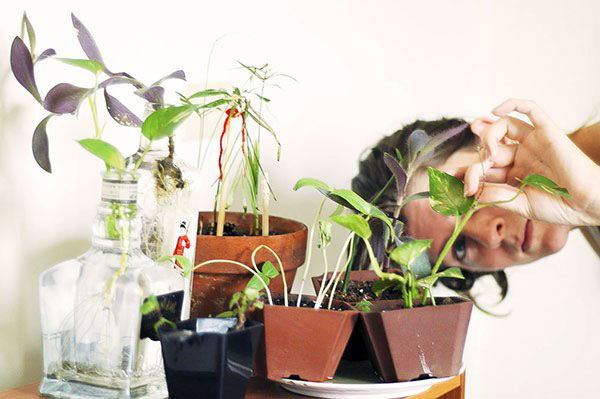
Immediately after purchase, the plant should be carefully examined to detect parasites and diseases.
On a note
There are cases when spider mites were found on plants decorating interiors in large chain stores - in Ikea, for example, as well as in restaurants. It is possible that pests accidentally get on things, bags, and then bring them into the house. It is also fraught with infection of indoor plants.
Even if new plants were not bought, all flowers in the home collection should be inspected regularly. This will allow you to detect ticks at the stage when they will not cause serious damage and they can be easily and quickly destroyed.
Finally, all new plants should be purchased from reputable suppliers who follow the necessary preventive and protective measures. In this case, the risk of buying an infected bush will be minimal.
Informative video about spider mites

